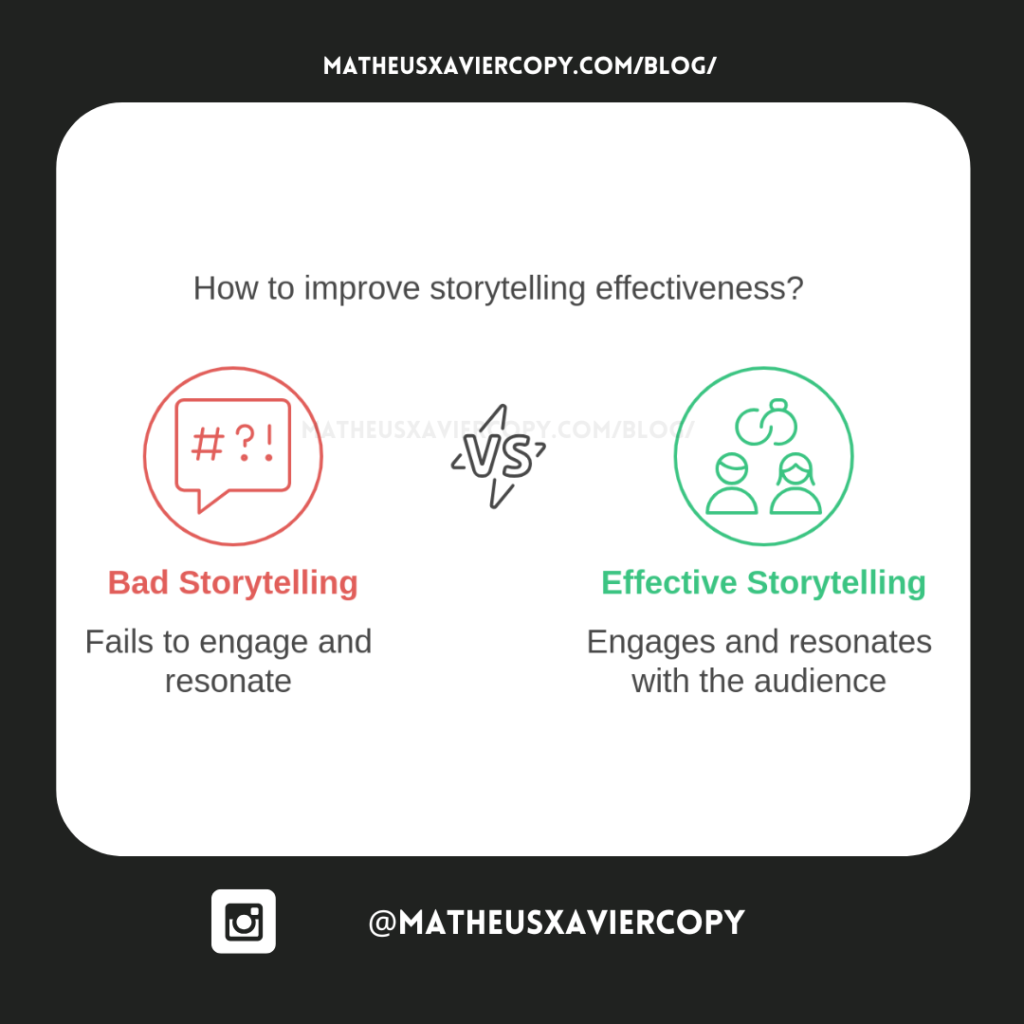Bad storytelling can have a destructive impact on your brand. In this article, I will show the top mistakes to avoid and how to create better pieces of marketing.

Bad Storytelling in 2024: Top Mistakes to Avoid in Marketing
Bad Storytelling: What is it?
When you hear the term “bad storytelling,” what comes to mind? Maybe a movie that had great potential but ended up feeling rushed or disconnected.

I’m a big Star Wars fan, and I know that most people don’t like Star Wars: The Last Jedi, but I love almost everything about it. However, everything fell apart when I watched Star Wars: The Rise of Skywalker because it is a soulless sequel.
Bad storytelling in marketing is no different—it’s when the story you’re trying to tell misses the mark. It’s a narrative that doesn’t resonate with your audience, doesn’t make them feel anything, and ultimately, doesn’t drive the action you want.
Let’s break it down in simpler terms. Imagine you’re watching a movie trailer. The trailer is short and packs a punch, right? It’s supposed to grab your attention and make you want to watch the movie.
Now, if that trailer starts with a confusing sequence of scenes, doesn’t introduce any characters, and lacks a clear plotline, how likely are you to be excited about the movie? Probably not very.
That’s what bad storytelling in marketing looks like—an unclear message that fails to pull in the audience. If you’re a freelancer, or you run a business, you’ve probably experienced bad storytelling firsthand.
Maybe you’ve seen an ad or website that doesn’t speak to your needs, or even worse, a brand message that feels like it was written by a robot. This kind of storytelling doesn’t just waste your audience’s time; it can even damage your brand.
Bad Storytelling: Top Mistakes to Avoid in Marketing
Bad storytelling in marketing can happen for several reasons. Let’s dive into the top mistakes that marketers, freelancers, and business owners make when trying to tell their stories.

Focus on the Brand, Instead of Your Customer
Have you ever watched an ad that seemed more like a commercial for the company than for the customer? It’s like playing a game where the main character does everything for themselves without considering the needs of others.
It’s selfish storytelling—and it won’t win you any friends. When you focus only on your brand and not on your customer’s needs, you lose the connection that’s essential for successful marketing.
Think about it: when you’re trying to market a product or service, who’s really at the center of the story? You, the brand, or the customer?
In my experience as a freelancer, I’ve seen businesses talk endlessly about their services without ever asking, “What’s in it for the customer?” If your story doesn’t resonate with your audience, why would they care?
A story that’s focused solely on your brand is like a movie that only talks about the camera equipment and never shows the characters or plot. The viewer is left confused and uninterested.
My piece of advice: Put your customer at the heart of the story. Instead of saying “Our company provides great software,” try something like, “Imagine solving your problems faster with software designed specifically for your needs.”
Lack of Authenticity and Opinion
Have you ever read something online that felt too perfect, like it was written by someone without an opinion or personality? It’s like listening to white noise—there’s no soul, no feeling.
When your storytelling lacks authenticity, it comes across as disingenuous. People can smell a fake story from a mile away, and they won’t trust your brand if they feel like you’re just telling them what you think they want to hear.
Share your opinions and be authentic. Some people won’t agree with you, and that’s fine. Your customers want to know what you stand for, even if it’s not always popular.
In my case, as someone who enjoys writing poetry, I understand how powerful it is to share my personal voice in my work. Some people won’t like it at all, but that’s fine. The same applies to your marketing—don’t be afraid to show the real you.
Overcomplicating the Message
Sometimes, marketers try to be so clever with their messaging that they end up making it hard to understand.
Have you ever played a video game where the controls are too complicated, and it just takes too long to figure out what to do? You start off frustrated, and it’s hard to enjoy the experience.
The same happens in marketing when you overcomplicate your message. If you have to explain your product or service in a paragraph, you’ve already lost your audience’s attention. The key is simplicity.
My piece of advice: Keep it simple, as if you’re talking to a 5-year-old. When you tell a story, don’t make your audience work too hard to understand the point. Think of it like Mario running through a level—simple, clear goals that everyone can follow.
Neglecting Emotions for the Transactional
Storytelling isn’t just about selling a product or service—it’s about creating an emotional connection. Imagine a movie that’s all action with no character development.
Sure, the explosions are cool, but you don’t really care about the characters, do you? Without emotional investment, the story falls flat.
In marketing, when you focus too much on the transactional side—just trying to get a sale—you miss the chance to build a relationship. And as I always say here: Sales are the result of a relationship.
Think about the last time you made a purchase. Was it because of the features alone, or did you feel something that motivated you to buy?
My piece of advice: Use your storytelling to connect emotionally with your audience. Tell stories that make people feel something, whether it’s excitement, hope, or even empathy. You don’t want to just sell them a product; you want to give them a reason to buy.
Forgetting the Call-to-Action
At the end of every good story, there’s a resolution. In marketing, that resolution is your call-to-action (CTA).
If you’ve ever watched a movie where the ending feels rushed or unresolved, you know how frustrating it can be. Similarly, when you tell a story without a clear CTA, it’s like leaving your audience hanging.
In my experience as a freelancer, I’ve seen websites and ads that don’t have a clear CTA. The user is left wondering, “What do I do now?” Without a clear next step, the story doesn’t lead anywhere.
You need to guide your audience to the action you want them to take—whether it’s signing up for a newsletter, making a purchase, or getting in touch.
My piece of advice: Start your copywriting process with a CTA in mind. Think of it as the final step in your journey. You’ve told them the story; now direct them to what’s next.
Bad Storytelling: Why It Kills Your SEO Efforts
If you’re involved in SEO (Search Engine Optimization) at all, you probably know that Google and other search engines prioritize user experience.
Bad storytelling directly impacts this. A story that doesn’t engage users means a higher bounce rate, which is detrimental to your SEO rankings.
Think of SEO as trying to get your website noticed in a crowded market. If your story isn’t compelling, people won’t stay on your page long enough for Google to notice.
Without quality content, you can’t build backlinks or gain social shares, both of which are vital for SEO.
My piece of advice: Optimize your storytelling for both humans and search engines. Craft engaging, informative content that holds the reader’s attention, and make sure your SEO strategy aligns with your narrative.
Bad Storytelling: How to Fix It?
So, how do we fix bad storytelling in marketing? Here are some actionable steps:

- Understand Your Audience: Start by knowing who you’re talking to. Develop buyer personas and tailor your stories to meet their needs.
- Be Authentic: Don’t be afraid to show your true colors. Share stories that reflect your brand’s personality and values.
- Simplify the Message: Clear, concise messaging is always better. Avoid jargon, and get to the point quickly.
- Create emotional connections: Make your audience feel something by being specific about the stories you share. Use storytelling to connect on a deeper level.
- Include a CTA: Always guide your audience to the next step. Whether it’s making a purchase or signing up for more info, don’t leave them guessing.
At the end of the day, storytelling is about connecting with your audience and creating an experience they won’t forget.
Think about the stories that resonate with you, and use those principles to craft your own. Whether you’re telling a story for a product, a service, or your brand, make sure it’s one worth hearing.
Now, think about it: if you heard that a movie had a plot that was clear, emotional, and impactful—wouldn’t you want to watch it? The same goes for your marketing story. Make it a movie they can’t miss.
Did you like our content about bad storytelling? Share it! And don’t forget to check out the brand-new articles we have on the blog to learn more and achieve the best results with your website.


























![How to make a headline? [Learn Copywriting in 3 steps]](https://matheusxaviercopy.com/wp-content/uploads/2024/11/Picsart_24-11-08_23-10-34-695-scaled.jpg)
![What is off-page SEO for website? [Understand in 1 minute]](https://matheusxaviercopy.com/wp-content/uploads/2024/11/Picsart_24-11-05_09-49-51-640-scaled.jpg)
![Content and SEO: Why do technology companies need it? [2024]](https://matheusxaviercopy.com/wp-content/uploads/2024/10/Picsart_24-10-15_17-25-02-236-scaled.jpg)


![SEO: What are the key elements? [Understand in 30 seconds]](https://matheusxaviercopy.com/wp-content/uploads/2024/10/Picsart_24-10-09_11-57-22-785-scaled.jpg)
![SEO: What is it in simple terms? [Understand in 30 seconds]](https://matheusxaviercopy.com/wp-content/uploads/2024/09/Picsart_24-09-10_11-16-03-082-scaled.jpg)


